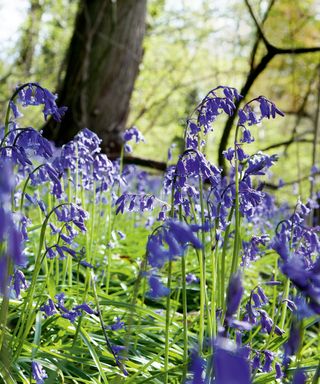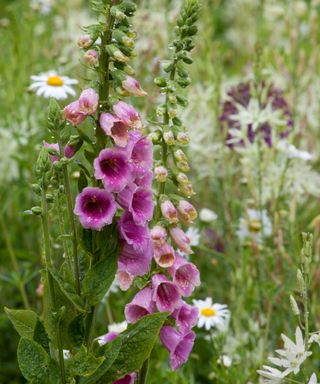When to plant wildflower seeds – for a colorful natural display
Find out when to plant wildflower seeds to enjoy their beauty and color and fill the backyard with wildlife


It’s essential to know when to plant wildflower seeds if you want to bring their informal charm and natural grace to your yard.
Their unfussy habit and gorgeous colors, paired with incredible flower power, make wildflower garden ideas irresistible. And their biggest draw is their ability to attract and provide for pollinators, such as bees and butterflies, which are a joy to share the yard with in summer.
Whether you want to use wildflowers to create a mini meadow or as part of your flower bed ideas, our guide has all you need to know on the peak times to sow and plant for the best results.
When to plant wildflower seeds
Thanks to the contemporary love of natural garden design and the zeal to be more wildlife-friendly and eco-minded, wildflowers are increasingly being grown in backyards. Many gardeners like to enjoy them as a ‘mini meadow’, which is easy and inexpensive to grow and provides colorful bloom for months.
‘The trend of wildflower meadows has hit our industry in a big, beautiful way,’ says Pennsylvania-based landscape designer Nathan Tuno of Roots Landscape Inc. ‘Our clients are more and more adding meadows to unused lawn areas, and they act as bird, bee, and butterfly sanctuaries.’
As to when to plant wildflower seeds, in general, spring and fall are the best times to direct sow and plant annual and perennial wildflowers. However, biennials (such as foxgloves) can be sown or planted in summer, and often so-called ‘wildflowers’ are not native, which means they may need to be sown under cover or sown at different times. If you prefer to make wildflower seed bombs, fall is best.
When to plant annual wildflowers
There are thousands of wildflowers and each has its own growing advice, so check with your supplier or read the seed packet. However, a general rule of thumb is that most hardy annual wildflowers that are native to your area can be sown direct in spring, and many can be sown direct in the fall.
When to plant perennial wildflowers
For the majority of perennial wildflowers that are native to your area, a spring sowing is best in cool regions and a fall sowing is ideal in hotter areas. However, there is a huge range of species available, so check with your supplier or read the back of the seed packet to discover any specific instructions on sowing or planting times.
When to plant an annual wildflower mini meadow
Many seed companies sell native and non-native ‘wildflower’ mixes that are composed of easy-to-grow seeds and a great mix of colors. For instance, Wildseed Farms in the US and Pictorial Meadows in the UK. If you want to create the unique look of your local area, make sure you choose a native mix.
‘Mini meadows can be a nice way to make wildlife habitat,’ says Ohio-based garden designer Ethan McGory. ‘Because there can be a sense of wildness to mini meadows, think about having a crisp, clear edge of paving or mown lawn, and sowing them in a simple shape like a large rectangle or circle.’
When to plant a perennial wildflower mini meadow
A spring or fall sowing is recommended everywhere, but the climate you live in will dictate which is the best season. If you’re in a cool, temperate region (such as the northern US or most of the UK), a spring sowing is better. But in warmer areas (including zones 7 to 11 in the US), a fall sowing is preferable, as the temperature allows the plants to establish a good root system at that time of year.
‘Start small,’ advises Nathan Tuno. ‘Pick an area on your property that does not see a lot of traffic, perhaps designate it as a “no-mow” area and start adding plant material like echinacea and bee balm. Also look up what the native pollinator flowers are in your area. In the northeast of the US, flowers like asters and Joe Pye are all the rage when it comes to going native.’
When to plant your favorite wildflowers
If you want to grow wildflowers, find out which plants are native to your area or non-invasive in your area.
Here is a selection of some good-looking wildflowers you might want to try growing in your backyard.
When to plant echinacea
Native to: eastern North America
The purple coneflower (Echinacea purpurea) is a good-looking perennial for the middle or back of the border and creates a wonderful prairie mood. Sow it under cover (for example, in a greenhouse) in late winter, spring, late summer, or fall.
‘My favorite native wildflower is echinacea,’ says Shannie McCabe, horticulturist for Baker Creek Heirloom Seeds. ‘It hosts a range of pollinators, it has a rich history of Native medicinal uses, and, of course, it’s a really beautiful plant. The wild E. purpurea that we see growing on roadsides is lovely, but those looking for a more domesticated spin on this favorite native wildflower can try ‘Green Twister’, which is equally easy to grow.’
When to plant Joe Pye weed
Native to: the US and Canada
Formerly known as Eupatorium and now classed as Eutrochium, the tall perennials known as Joe Pye weed have an informal charm and attract lots of butterflies when their dusky pink or ivory flowers bloom in late summer and early fall. Sow them under cover in spring (for example, in a cold frame) or sow direct outside in early summer.
For British gardeners, hemp agrimony (E. cannabinum) is native to Europe and closely related.
When to plant sea kale
Native to: Europe
Fabulous in a gravel garden, sea kale (Crambe maritima) has superb wavy blue-green foliage that is topped with sprays of tiny white flowers in early summer. Purchase this tough perennial from a specialist seed supplier and sow as soon as possible upon receiving it, at any time of year, under cover – for example, in a greenhouse.
‘Our Crambe seeds are dispatched from cold storage and should be sown immediately upon receipt,’ says Nina Marshall at Chiltern Seeds, ‘and therefore they can be started at any time of year. They germinate irregularly over a long period of time and are best sown with a given temperature of 64°F (18°C) for eight weeks. If germination does not occur in this time, then cold stratify for eight weeks. This can be achieved by either using the natural winter cold or by placing the tray in the fridge.’
When to plant milkweed
Native to: North and South America
Butterflies love milkweeds, such as Asclepias syriaca, which is native to southern Canada and the eastern US.
‘Milkweed blooms later in the summer, just in time for the Monarch butterfly migration,’ says Catherine Kaczor, Sales Manager at Hudson Valley Seed Co. ‘Its flowers and leaves provide food, shelter, and protection for the Monarchs. Urbanization has dramatically decreased the habitat in which milkweed thrives, so any attempt to simulate that environment in our yards or gardens helps the Monarch population.’
Sow direct into soil outside in fall or early winter; alternatively, sow in spring, placing containers in a fridge initially, before moving them to a greenhouse or sunny windowsill.
‘Milkweed, because it is native to the Northeast, needs to be “cold-stratified”,’ says Catherine. ‘This means that the seeds must be subjected to cold and moist conditions in order to grow. This is very easy for us in the Northeast. All you have to do is sow in late fall and let the winter weather take care of the rest.’
When to plant bluebells

Native to: Western Europe
The beautiful Hyacinthoides non-scripta is the bluebell that carpets British woodland with scented bells in late spring and early summer. Bulbs are the more usual way of growing bluebells, but they can be grown from seed in fall or winter, which saves money if you have a large area to naturalize.
‘Although these seeds can be sown year round, they are best sown in the fall or winter as a period of six to eight weeks of cold weather is needed for the seeds to germinate,’ says Nina Marshall. ‘Results show the following spring from sowing. Grow on undisturbed for two years. They require little attention so sow and forget!’ Sowing in a cold frame is ideal to keep mice away.
When to plant bee balm
Native to: North America
Monarda (commonly known as bee balm or bergamot) produces pink or red punk-hair flowers, which provide for pollinators in summer. There are several species in the US, including widely grown aromatic M. fistulosa and lemon-scented M. citriodora, as well as the more unusual exotic-looking M. punctata.
Sow M. fistulosa under cover in spring or sow direct outside in late summer or early fall; sow M. citriodora under cover in spring or sow direct outside from mid-spring to late summer; and sow M. punctata under cover in March or April or sow outside in fall.
When to plant chicory
Native to: Europe
Chicory (Cichorium intybus) is a tall perennial that is sometimes grown for salad leaves or as a coffee substitute, but is more commonly cultivated as an ornamental. Native to Europe and naturalized in North America, it produces gorgeous sky-blue daisy flowers in summer.
It can be sown direct in spring, but is best sown direct in late summer or early fall for flowers the following year. If you want flowers this year, buy young plants (usually sold in the herb section of nurseries) instead. In the right conditions, chicory will self-sow.
When to plant foxgloves

Native to: Europe
The biennial foxglove (Digitalis purpurea) sends up spires of pink hooded flowers, which bumblebees visit for nectar. The white form (Digitalis purpurea f. albiflora) is very elegant and easy to grow from seed.
As for planting foxgloves, they can be sown under cover in early spring or sown under cover or direct in late spring or early summer. If you have foxgloves growing already, collect the seed in summer once the flower spikes are spent and either sow it under cover or direct where you want them to grow.
Foxgloves are biennial. ’The plants focus on their green growth in the first year and will then reward you with flowers the following spring and summer,’ says Nina Marshall. Therefore, to ensure flowers every year, do a sowing next year as well. Since foxgloves self-sow, once you have enough in the garden, you won’t need to sow any.
When to plant aster
Native to: North America
Symphyotrichum are asters native to the US that brighten the garden in late summer and fall. These hardy perennials produce daisy flowers that have an informal charm and attract a range of pollinators, including bees and butterflies.
They are great for prairie-style borders or perennial wildflower meadows. There are several forms to choose from, including S. oblongifolium (aromatic aster), S. laeve (smooth aster), and S. novae-angliae (New England aster). Sow them under cover in early spring or sow direct outside in late spring after risk of frost has passed.
What is a wildflower?
A wildflower is a plant that is native to your region. What is and isn’t native may be surprising. For instance, in the UK, many people think of cornflowers as wildflowers, but in fact they are native to Greece and Italy. This is why many suppliers label so-called ‘wildflowers’ as native or non-native.
Why grow wildflowers?
Wildflowers offer the unique quality of being native to the area in which you live. This means they are often the best plants to grow to achieve a beautiful natural look. They’re also certain to be hardy and to benefit the local wildlife, and you can relax knowing they won’t escape the backyard and become invasive monsters (as so many non-native plants have done in the US).
Are non-native wildflowers invasive?
Not necessarily. If you are – rightly – wary of planting something that may be invasive, check with your supplier or on the seed packet. Choose species labeled as ‘non-invasive’. This means they won’t wreak havoc in your local countryside. For more information, seek out the national resources on invasive and non-invasive plants in your country, such as the US Forest Service.
Sign up to the Homes & Gardens newsletter
Decor Ideas. Project Inspiration. Expert Advice. Delivered to your inbox.
Rachel is senior content editor, and writes and commissions gardening content for homesandgardens.com, Homes & Gardens magazine, and its sister titles Period Living Magazine and Country Homes & Interiors. She has written for lifestyle magazines for many years, with a particular focus on gardening, historic houses and arts and crafts, but started out her journalism career in BBC radio, where she enjoyed reporting on and writing programme scripts for all manner of stories. Rachel then moved into regional lifestyle magazines, where the topics she wrote about, and people she interviewed, were as varied and eclectic as they were on radio. Always harboring a passion for homes and gardens, she jumped at the opportunity to work on The English Home and The English Garden magazines for a number of years, before joining the Period Living team, then the wider Homes & Gardens team, specializing in gardens.
-
 Decluttering tips for collectors and hoarders – how to compromise with clutter
Decluttering tips for collectors and hoarders – how to compromise with clutterProfessional organizers share their best decluttering tips for collectors and hoarders to help you limit your collections and piles of clutter without decimating sentimental spaces
By Chiana Dickson Published
-
 Pottery Barn is offering 30% off on all outdoor furniture – your chic backyard refresh is just a few clicks away
Pottery Barn is offering 30% off on all outdoor furniture – your chic backyard refresh is just a few clicks awayPottery Barn is having a sale on all their outdoor items, from seating and tables to rugs and throws. These are the best outdoor pieces I’m adding to my cart
By Nikhita Mahtani Published